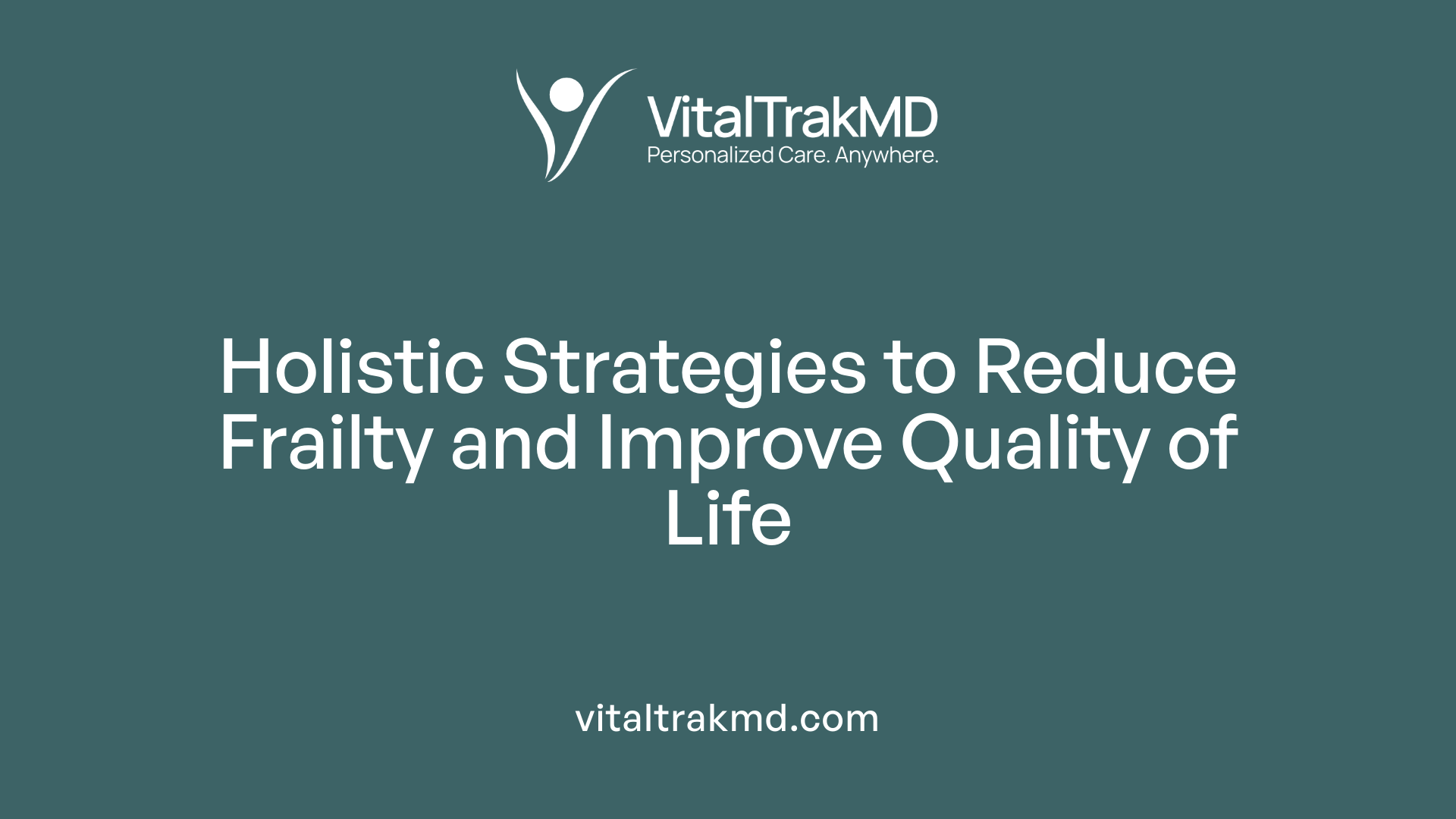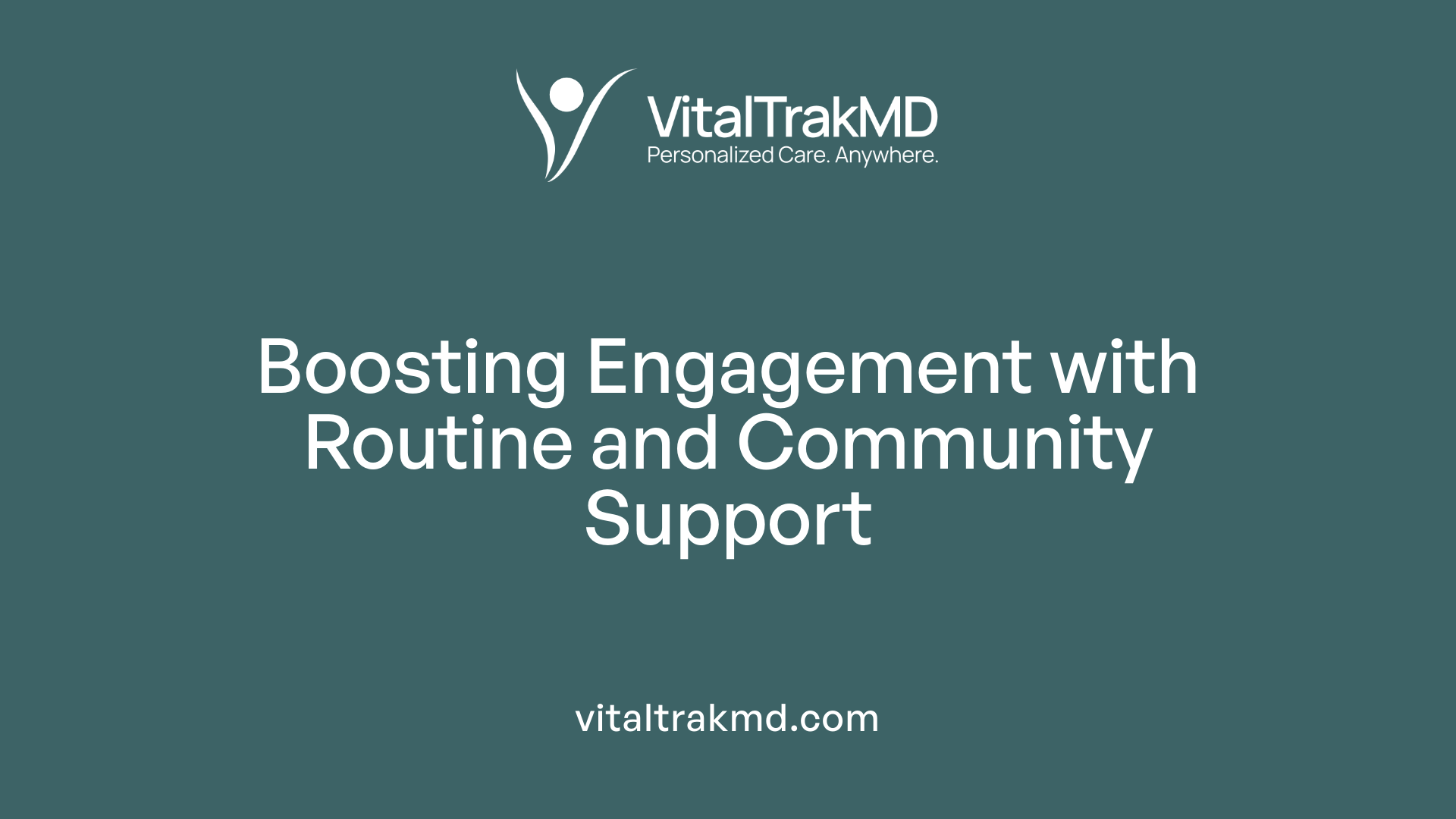The Role of Hybrid Care in Keeping Seniors Focused on Health Goals

Understanding the New Paradigm in Senior Wellness
As the aging population grows rapidly, innovative approaches to senior care are crucial. Hybrid care models combining in-person and digital health interventions offer a comprehensive strategy to help older adults maintain and improve their health, focusing on holistic wellness, weight management, and mental health.
The Demographic Imperative: Aging Population Trends

Population Growth of Seniors
The aging population in the United States is expanding rapidly. In 2018, there were 52.4 million individuals aged 65 and older, and projections indicate that by 2030, this group will comprise 20% of the total population. Notably, by that year, there will be more people over 65 than those younger than five years old. This demographic shift is creating a significant demand for specialized healthcare and social services tailored for older adults.
Diversity Within the Older Adult Demographic
Older adults represent a highly heterogeneous population. Variations exist across racial, ethnic, cognitive, and health status lines, meaning that the senior population is far from uniform. Such diversity requires that healthcare and social support systems adopt personalized and culturally sensitive approaches to effectively address the wide-ranging needs and preferences within the older adult group.
Implications for Healthcare Needs
This demographic imperative presents numerous challenges and opportunities for healthcare delivery. Advances in science and technology have made prevention and high-quality clinical care increasingly attainable for seniors. However, equitable, person-centered care depends heavily on policy changes and healthcare system adaptations. Integrated care models that address mobility, medication, mentation, and patient priorities—the '4Ms' framework—are critical to improving quality and safety in older adult care. Additionally, social determinants of health, including housing stability, food security, and social connectivity, must be prioritized due to their significant influence on health outcomes. To meet these evolving needs, innovations such as telehealth, remote patient monitoring, and expanded electronic health record access are essential components of modernizing care for an aging population.
Holistic Hybrid Care Models: Bridging Community and Technology

What Is a Hybrid Care Model for Older Adults?
A hybrid care model integrates both community-based and digital components to provide comprehensive support to older adults. This approach combines in-person care—such as caregiver support and community evaluation—with technology-driven interventions like digital health coaching and self-monitoring apps. The goal is to enhance holistic care by addressing the multifaceted needs of seniors, spanning physical, psychological, and social dimensions.
How Do Community-Based and Digital Elements Work Together?
Community-based care emphasizes continuity, caregiver engagement, and social support, which foster adherence to health programs and bolster older adults’ self-care abilities. In parallel, digital interventions employ tools such as mobile apps, telephone coaching, and reminders that allow seniors to self-manage chronic conditions and maintain communication with care providers remotely. This blended approach facilitates accessibility, especially for those living alone or with mobility limitations, while enhancing digital literacy and engagement among participants.
Addressing Frailty and Multiple Health Domains Holistically
The hybrid model expands beyond traditional care by focusing on frailty as a reversible condition. It incorporates comprehensive assessments using tools like the Frail-VIG scale and Short Physical Performance Battery (SPPB) to measure outcomes across physical function, nutrition, social vulnerability, and mental health. Behavioral interventions grounded in self-efficacy and social interdependence theories empower older adults to take active roles in their health management. Outcomes from studies show significant improvements, including reductions in frailty scores, enhanced physical performance, better nutritional status, and decreased depression and health distress.
This holistic framework aligns with broader efforts that recognize the complex interplay of medical, psychological, and social determinants affecting older adults. By combining human coaching with technology and community resources, hybrid care models offer promising pathways to improve quality of life and reduce healthcare disparities in an aging population.
Measuring Frailty and Physical Performance in Seniors

What assessment tools are used to measure frailty and physical performance in older adults?
To effectively gauge frailty in seniors, comprehensive tools like the Frail-VIG scale are commonly used. This scale helps identify various frailty domains, providing a detailed look at an individual's vulnerability. Alongside this, the Short Physical Performance Battery (SPPB) score assesses physical functioning by evaluating balance, gait speed, and lower body strength.
Why is the SPPB score important in assessing seniors?
The SPPB is a vital measure because it offers clear insights into a senior's mobility and risk of disability. Improvements in SPPB scores are linked with better physical performance and reduced frailty. This metric is valuable for monitoring progress in interventions designed to enhance mobility and overall function.
What outcomes relate to physical function improvements?
The use of these assessment tools supports the observation of meaningful outcomes, such as an increase in physical functioning and a notable reduction in frailty levels. For example, interventions that incorporate these measures have shown shifts toward lower frailty scores and improved balance and strength metrics, indicating better overall health and independence in older populations.
Empowering Seniors through Self-Care Training and Caregiver Support

How are self-care practices implemented to support seniors?
Self-care training for older adults focuses on equipping them with knowledge and skills to manage their health proactively. This approach encourages seniors to take an active role in their own well-being, particularly in areas affected by frailty and chronic conditions. Training sessions guide seniors in nutrition, physical activity, and medication management, promoting healthier lifestyles that can improve physical and mental health outcomes.
What role do caregivers play in reinforcing care?
Caregivers are pivotal in supporting seniors’ self-care efforts. The hybrid care model emphasizes reinforcement by caregivers, who provide practical assistance and emotional support. This continuous encouragement helps seniors adhere to health recommendations and maintain motivation. Caregiver involvement fosters continuity of care within the community, ensuring that seniors do not feel isolated in their health journey.
Which theories influence the design of these interventions?
The interventions are grounded in self-efficacy and social interdependence theories. Self-efficacy theory underlines the importance of building seniors’ confidence in managing their health, empowering them to overcome challenges. Meanwhile, social interdependence theory highlights the benefit of collaborative relationships, recognizing that interaction with caregivers and peers enhances motivation and health behaviors. Together, these theories shape a comprehensive framework that supports sustainable behavior change and improved outcomes for older adults.
Behavioral Multi-Domain Interventions and Their Impact on Frailty

How do behavioral multi-domain interventions reduce frailty in older adults?
Behavioral multi-domain interventions have demonstrated significant success in reducing frailty among older persons. In one study, an intervention group experienced an approximate 0.19-point decrease in the frailty index compared to the control group. This suggests that frailty, once considered a progressively worsening condition, may be reversible through targeted behavioral approaches that address multiple domains simultaneously.
What improvements accompany the reduction in frailty?
Beyond a reduction in frailty index scores, these interventions led to notable improvements across several important health domains. Social vulnerability was decreased, implying enhanced social support and reduced isolation. Nutritional status among participants improved, reflecting better diet and self-care. Physical functioning also saw gains, including higher scores on the Short Physical Performance Battery (SPPB) that measures balance, gait speed, and lower limb strength. This shift towards lower frailty levels marks a meaningful improvement in overall functionality and quality of life.
The comprehensive nature of these interventions involves training older adults in self-care practices, supported by caregivers and grounded in self-efficacy and social interdependence theories. This holistic approach strengthens both physical and psychosocial health, addressing the complex needs of seniors managing frailty within their community settings.
Personalizing Care: Influence of Sociodemographic Factors on Outcomes

How Do Age, Gender, and Income Affect Senior Care Outcomes?
Sociodemographic factors such as age, gender, and income significantly shape the effectiveness of interventions designed for older adults. Older individuals are not a homogeneous group; their varying backgrounds impact how they respond to care models. For instance, females have been observed to experience a faster progression of frailty if they do not receive timely intervention. Income levels can influence access to resources and, consequently, the ability to engage in self-care practices effectively.
What Role Does Family Support Play?
Family support emerges as a crucial factor in reinforcing the benefits of hybrid care models. Older adults with strong family involvement tend to have better adherence to health programs. The presence of caregivers not only bolsters the individual’s self-efficacy but also provides continuity of care and motivation to maintain health behaviors. This social environment helps improve outcomes across multiple domains, from nutrition to physical functioning.
How Do Differences in Frailty Progression Influence Interventions?
Variations in frailty progression linked to sociodemographic characteristics underscore the need for personalized approaches. For example, men and women may experience distinct patterns of decline and recovery, requiring tailored strategies. Understanding these differences enables healthcare providers to adapt their interventions, ensuring that those at greater risk receive targeted support.
In sum, accounting for age, gender, income, and family dynamics enhances the design and delivery of community-based care for seniors, making programs more effective and equitable.
The Digital Health Coaching Self-Management Program Overview

What is the DHCSMP-MCC program?
The Digital Health Coaching Self-Management Program for Multimorbidity in Community-dwelling older adults (DHCSMP-MCC) is a hybrid initiative designed to support older adults living alone with multiple chronic conditions. This program blends personalized health education with digital technology to empower seniors in managing their health effectively.
How long is the intervention and what does it include?
The intervention spans eight weeks and incorporates several components:
- Education sessions: Information on health management tailored to multimorbidity.
- Personalized health coaching: Delivered via telephone, helping participants set and reach health goals.
- Self-monitoring: Using a mobile application for tracking health parameters and progress.
- Reminders: Regular prompts via digital means to encourage adherence to self-care practices.
How are digital tools and telephonic coaching integrated?
The program uniquely combines human support through personalized telephonic coaching with digital engagement via a mobile app. This integration ensures participants not only receive expert guidance but also develop digital literacy skills, enhancing their comfort with health technologies. The blend of in-person coaching and remote digital tools makes the program accessible and adaptable, increasing senior participation and fostering sustained engagement.
By employing this comprehensive, mixed-methods approach, DHCSMP-MCC addresses both the medical and psychosocial needs of older adults managing multiple health conditions.
Psychological Benefits of Digital Health Coaching for Seniors

How does digital health coaching reduce health distress and depression among older adults?
Digital health coaching programs designed for older adults, especially those living alone with multiple chronic conditions, have demonstrated significant improvements in psychological health outcomes. By combining personalized health coaching via telephone and self-monitoring through mobile applications, these interventions effectively reduce symptoms of health distress and depression. This reduction occurs as the coaching supports seniors in managing their health conditions more confidently and lowers feelings of anxiety related to health uncertainties.
What role does social support from coaching play in these outcomes?
A principal driver behind the psychological benefits of digital health coaching is the increased social support provided through regular coaching interactions. These engagements foster a sense of connection and reassurance, which is particularly valuable for seniors who might otherwise experience social isolation. The coaching sessions help participants feel heard and supported, reinforcing their motivation to maintain health-promoting behaviors and thereby enhancing psychosocial well-being.
How are overall psychosocial outcomes improved by digital health coaching?
Beyond reducing distress and depression, digital health coaching can improve broader psychosocial outcomes by enhancing participants' digital literacy, enabling more effective communication and engagement with health technologies. The blend of human coaching with digital tools offers an accessible, adaptable approach that encourages sustained participation and social interaction. This combination not only promotes better mental health but also empowers seniors in self-management, contributing to improved quality of life and social connectedness.
Enhancing Digital Literacy Among Older Adults
How Did App Usage Improve Among Older Adults?
The digital health coaching self-management program (DHCSMP-MCC) included personalized health coaching via telephone and the use of a mobile app for self-monitoring. This approach significantly enhanced participants' ability to use digital tools, especially mobile applications. Many older adults showed increased confidence in navigating the app, leading to better management of their health conditions. This improvement was crucial for those living alone with multiple chronic diseases, as the app enabled regular self-assessment and timely health interventions.
What Role Does the Program Play in Bridging the Digital Divide?
Older adults often face barriers to technology use due to limited digital literacy. The intervention addressed this by integrating both in-person and remote support, ensuring users were not left behind due to technical challenges. By providing structured coaching and step-by-step guidance, the program reduced health disparities related to technology access and use. This empowerment helped bridge the digital divide and made digital health tools accessible for a population that traditionally has lower engagement with such technology.
How Does the Program Facilitate Sustained Engagement With Technology?
Participants' high engagement, measured through goal attainment scaling (GAS), demonstrated that combining human coaching with digital health tools enhances motivation and adherence. Health coaching encouraged continuous interaction with the app, covering topics such as healthy diet and oral health, which often exceeded expectations. The blend of digital and personal support created an adaptable experience accommodating varying levels of digital familiarity, promoting ongoing use and benefits from technology.
These findings illustrate that tailored digital health programs, which include coaching and support, are effective in improving digital literacy among older adults. This improvement not only advances health self-management but also fosters psychosocial benefits by integrating technology into everyday life.
The Role of Individual and Family Self-Management Theory in Program Design
What is the IFSMT framework?
The Individual and Family Self-Management Theory (IFSMT) provides a structured approach to understanding how individuals and their families manage chronic conditions, including the complexities faced by older adults. It emphasizes the interplay between contextual factors, self-management processes, and health outcomes, guiding the design of programs that address the multifaceted needs of seniors.
How do contextual, process, and outcome factors influence self-management?
Contextual factors include personal characteristics, health status, and environmental influences such as family support and community resources. Process factors focus on knowledge acquisition, self-regulation, and social facilitation, which underpin an individual's ability to engage in self-care. Outcome factors measure the effectiveness of interventions, including physical health improvements, psychological well-being, and behavioral changes.
What impact does the IFSMT have on self-management success?
By framing interventions within the IFSMT, programs can offer tailored coaching and digital tools that reflect each senior's context and needs. This comprehensive perspective enhances engagement, fosters behavioral change, and improves clinical and psychosocial outcomes. For example, integrating personalized health coaching with technology under the IFSMT has shown to reduce health distress and depression, while increasing digital literacy among older adults, ultimately supporting sustainable self-management in aging populations.
Accessibility and Adaptability: Combining In-Person and Remote Care Elements
Hybrid model advantages
The hybrid care model for older adults blends in-person and remote care to offer a comprehensive, community-based approach. This model supports continuity of care and caregiver reinforcement, which enhances seniors’ adherence to health programs. By integrating face-to-face interactions with digital tools, it ensures personalized support while expanding reach beyond physical appointments.
Overcoming barriers to technology use
Older adults often face challenges engaging with digital health due to limited digital literacy. The hybrid model addresses this by combining personal coaching with technology, such as mobile apps for self-monitoring and telephonic health coaching. Studies show significant improvement in participants’ digital skills, enabling better engagement with health tools and reducing the digital divide, especially for those living alone with multiple chronic conditions.
Flexibility for seniors’ diverse needs
Seniors are a heterogeneous group with varying cognitive, physical, and social needs. The hybrid approach is adaptable, allowing older adults to participate according to their preferences and capabilities. Whether through in-person support to build trust and motivation or remote elements to provide convenience and ongoing monitoring, the model accommodates diverse contexts, promoting better health outcomes and psychosocial benefits.
| Aspect | Description | Impact on Seniors |
|---|---|---|
| Hybrid model | Combines in-person care with remote digital tools | Enhances adherence and personalized support |
| Technology coaching | Provides digital literacy support and health app usage guidance | Bridges digital divide and empowers self-management |
| Flexible participation | Offers multiple modes for engagement depending on needs and resources | Meets diverse health, cognitive, and social contexts effectively |
Human Support and Digital Tools: Synergy for Health Improvement
How does integrating human coaching with digital technology benefit older adults?
Combining personalized coaching with digital health tools creates a powerful approach to improve health outcomes for older adults. Programs like the Digital Health Coaching Self-Management Program (DHCSMP-MCC) use telephone coaching alongside mobile app monitoring to provide education and reminders tailored to individuals with multiple chronic conditions. This blend helps bridge the digital divide by enhancing participants' digital literacy and facilitating adoption of technology in self-care.
In what ways can this integration enhance psychosocial and physical health outcomes?
This hybrid model shows notable reductions in health distress and depression, likely linked to increased social support generated by human coaching interactions. Furthermore, physical functioning improves through self-management guided by personalized goals, reflected in better nutritional status and increased mobility scores. Such comprehensive care addresses both physical and psychological aspects of frailty in a community setting.
How does this model support sustained motivation and accountability among seniors?
The inclusion of human support reinforces continuity of care and encourages adherence to health goals, while digital tools provide incentives like reminders and progress tracking. Engagement methods such as goal attainment scaling motivate participants by making achievements measurable and meaningful. Social interdependence fostered by coaching relationships helps maintain participation, ensuring that older adults stay committed to lifestyle changes over time.
Key Components of Effective Wellness Programs for Seniors
What are the key components of effective wellness programs?
Effective wellness programs for seniors are designed to promote holistic health and prevent illness by addressing various aspects of well-being. These programs typically include the following components:
Physical Activity Initiatives: Seniors engaging in community-based physical activity sessions or fitness programs benefit from improved health-related quality of life, better physical functioning, and reduced healthcare costs. Frequent and sustained participation amplifies these positive outcomes.
Nutrition Education: Nutrition guidance supports better dietary habits, improves nutritional status, and complements physical activity. Wellness programs that include education on healthy diets contribute to better overall senior health and encourage behavior change.
Mental Health Support: Addressing psychosocial factors such as depression and health distress is crucial. Programs incorporating health coaching or digital health interventions have demonstrated reductions in depression and distress among older adults. This mental health support can be mediated through increased social support and engagement with caregivers or coaches.
Health Screenings: Regular assessments, including evaluations of frailty and physical performance, help to monitor health status. Tools such as the Frail-VIG scale and Short Physical Performance Battery (SPPB) scores enable tailored interventions and track improvements over time.
Additionally, effective programs often use digital tools like mobile health apps and remote coaching to enhance engagement and self-management skills among seniors. Incorporating social connections and community involvement encourages ongoing participation, which is linked to better health outcomes. Programs also benefit from integrating caregiver training and reinforcing continuity of care to support seniors living independently.
By combining these elements, wellness programs create a comprehensive, person-centered approach that improves physical, nutritional, and mental health outcomes while reducing healthcare utilization and costs.
Supporting Weight Loss Through Structured Care Programs

How can structured care programs support weight loss efforts?
Structured care programs offer a comprehensive approach to weight loss by combining personalized guidance with consistent support, creating an environment where individuals can effectively work toward their goals. These programs typically feature lifestyle and nutritional counseling tailored to each participant's needs, helping to establish healthier eating patterns and sustainable habits.
Anti-obesity medications are often integrated into care plans when appropriate, enhancing the effectiveness of lifestyle modifications. Exercise programs form a crucial component, with aerobic interval training proving especially beneficial for improving metabolic health—even in cases without notable weight loss. This type of training boosts endurance and supports functional improvement, contributing to overall well-being.
Accessibility is a focus within community-based programs, which are frequently led by trained primary care providers. This approach ensures that weight management resources are readily available, facilitating clinically meaningful weight loss; studies have shown that approximately 53% of participants achieve a reduction of over 5% in body weight.
Beyond initial interventions, structured programs emphasize ongoing follow-up through telephone or online platforms. These outlets reinforce physical activity engagement and behavioral changes, supporting long-term maintenance of weight loss and healthier lifestyles.
By combining personalized care, medical support, exercise guidance, and continuous follow-up, structured programs empower individuals to make lasting changes conducive to improved health outcomes.
The Critical Role of Mental Health in Successful Weight Management

What role does mental health play in successful weight management?
Mental health significantly influences weight management by shaping eating behaviors, motivation levels, and overall well-being. Psychological conditions such as depression, anxiety, and trauma often correlate with challenges in maintaining a healthy weight. These conditions may trigger emotional eating, reduce motivation for physical activity, or foster unhealthy habits, making weight loss more difficult.
How do depression, anxiety, and trauma affect eating behavior?
Depression and anxiety can lead to appetite changes, either increasing or decreasing food intake. Trauma may intensify emotional eating as a coping mechanism. These emotional states disrupt regular eating patterns and can promote consumption of nutrient-poor or calorie-dense foods, hindering weight control efforts.
What strategies support mental health in weight management?
Therapies including cognitive-behavioral therapy and counseling offer tools to manage negative emotions tied to eating habits. Mindfulness techniques help individuals become more aware of hunger cues and reduce impulsive eating. Developing a positive mindset encourages motivation and long-term commitment to healthier lifestyles. Incorporating behavioral therapies addresses emotional triggers and improves self-efficacy.
How does emotional support contribute to weight management success?
Emotional support from family, friends, or support groups provides encouragement and accountability. It reduces feelings of isolation and promotes resilience during challenges. Networks—both in-person and online—offer shared experiences, which can strengthen commitment and bolster mental well-being essential for sustained behavior change in weight management.
Effective Strategies for Long-Term Weight Loss Maintenance

Which strategies are most effective for long-term weight loss maintenance?
Effective long-term weight loss maintenance centers on sustainable lifestyle changes that are manageable and adaptable over time. Incorporating regular physical activity is crucial, with a recommended target of burning approximately 1,500 to 2,000 calories weekly through moderate exercises such as walking or stair climbing. These activities not only support caloric balance but also improve physical functioning and overall health.
Balanced nutrition plays a vital role, focusing on a low-fat diet and gradual dietary adjustments. For example, increasing calorie intake by about 200 calories from healthy food sources can help individuals find the ideal energy balance without compromising weight goals.
Behavioral tools are essential to support adherence and success. These include self-monitoring techniques, managing stress-related or emotional eating, controlling portion sizes, and limiting high-calorie, low-nutrition foods. Such methods help to maintain awareness and control over eating habits.
Psychological strategies complement behavioral tools by building self-efficacy, perseverance, and resilience. These qualities empower individuals to remain motivated and committed despite setbacks, which are common in the journey of weight maintenance.
Support systems also critically influence long-term success. Participation in community-based programs or maintaining personal support networks encourages accountability and motivation. This social connection not only enhances engagement but may reduce social isolation – a key factor affecting older adults’ health outcomes.
Overall, achieving and maintaining weight loss is a multifaceted process. It demands consistent effort, mindfulness about lifestyle choices, psychological resilience, and the presence of supportive relationships to help navigate environmental and social challenges effectively.
Social Determinants of Health and Their Impact on Senior Wellness

Housing and Food Security
Adequate housing and reliable access to nutritious food are fundamental social determinants that significantly influence the health and wellness of older adults. Stable housing provides a safe environment that supports mobility and reduces injury risk. Meanwhile, food security ensures that seniors receive necessary nutrients that sustain physical health and prevent malnutrition.
Social Isolation
Social isolation is a critical factor that adversely affects older adults' mental and physical well-being. Lack of social connections can lead to increased feelings of loneliness, depression, and reduced motivation to engage in healthy behaviors. Programs that foster social ties and community participation are essential to counteract these effects and support sustained engagement in wellness activities.
Effect on Health Outcomes
These social determinants play a vital role in shaping health outcomes among seniors. Housing instability, food insecurity, and isolation compound vulnerability to chronic diseases and frailty. Addressing these factors through community-based interventions and support services helps improve nutritional status, physical function, and psychological health, ultimately reducing healthcare utilization and costs among the aging population.
Addressing Healthcare Disparities and Policy Needs for Equitable Senior Care

What are the systemic inequities affecting older adults in healthcare?
The COVID-19 pandemic exposed deep-rooted systemic inequities in the US healthcare system that disproportionately affect older adults. These disparities are seen in unequal access to care, differences in quality, and outcomes worsened by social determinants such as housing instability, food insecurity, and social isolation. Older adults with diverse racial, ethnic, cognitive, and socioeconomic backgrounds are especially vulnerable to these gaps in care.
How do policy frameworks support equitable, person-centered care for seniors?
Effective policy frameworks are essential for ensuring that older adults receive equitable and person-centered care. The adoption of evidence-based models like the '4Ms' framework—which focuses on what matters to the individual, mentation, medication, and mobility—guides age-friendly health systems in delivering quality care tailored to seniors' unique needs. Policies that prioritize prevention, optimized clinical care, and integration of social determinants are critical for improving outcomes.
What standards are needed for person-centered care in senior health systems?
Person-centered care for older adults requires standards emphasizing holistic, community-based support that respects individual preferences and contexts. This includes seamless coordination across healthcare and social services, caregiver support, and continuity of care. Incorporating advances such as telehealth and digital health coaching helps bridge access gaps, while redesigned long-term services enable aging in place. Ultimately, responsive policies must foster equity, reduce disparities, and promote dignity in senior care delivery.
Age-Friendly Health Systems and the '4Ms' Framework

What Matters to Seniors
Understanding what matters to seniors is the cornerstone of age-friendly health systems. This involves recognizing each older adult’s unique values, preferences, and goals for their care. By focusing on personalized care plans that align with these priorities, healthcare providers can enhance engagement and satisfaction, promoting health outcomes that truly reflect patients’ desires.
Mentation, Medication, Mobility
The '4Ms' framework further addresses critical clinical areas: mentation, medication, and mobility. Mentation focuses on maintaining cognitive health by preventing and managing issues such as delirium, dementia, and depression. Medication management ensures that older adults receive appropriate prescriptions, minimizing polypharmacy and adverse drug events. Mobility emphasizes the importance of physical function, fall prevention, and promoting independence through activities such as exercise and physical therapy.
Improving Care Quality and Safety
Implementing the 4Ms framework improves care quality and safety by providing a comprehensive, evidence-based approach tailored to older adults’ needs. It fosters coordination across healthcare teams and settings, reduces hospitalizations related to medication errors or falls, and enhances overall well-being. Through this model, health systems can deliver care that is both person-centered and accountable, addressing the complexities inherent in aging populations.
Telehealth and Remote Monitoring as Tools in Senior Care
How Has Technology Improved Care Delivery for Older Adults?
Technology-enabled care delivery, especially telehealth and remote patient monitoring, has transformed how care is provided to seniors. These tools allow healthcare providers to remotely track health conditions, offer consultations, and provide personalized coaching without requiring older adults to travel. This approach supports aging in place, making access to healthcare more convenient and continuous.
What Role Did the COVID-19 Pandemic Play?
The COVID-19 pandemic acted as a catalyst accelerating the adoption of telehealth services. It exposed vulnerabilities in traditional healthcare for older adults and highlighted disparities and systemic inequities in access. Telehealth emerged as a critical solution to maintain care while minimizing infection risks, facilitating safer interactions and maintaining essential health services.
How Do Telehealth and Remote Monitoring Improve Accessibility and Outcomes?
Remote health technologies increase accessibility by overcoming barriers such as mobility limitations and transportation challenges. Programs integrating digital tools, like digital health coaching self-management, have improved psychological health outcomes—reducing distress and depression—and enhanced digital literacy among older adults. Furthermore, combining human support with technology promotes adherence and better health outcomes through continued engagement and social support.
| Aspect | Description | Impact on Senior Care |
|---|---|---|
| Technology-enabled Delivery | Use of mobile apps, telehealth calls, remote monitoring | Enables continuous, convenient care; supports self-management |
| COVID-19 Catalyst | Accelerated telehealth adoption due to pandemic safety | Ensured care access during lockdowns; highlighted healthcare gaps |
| Improved Accessibility | Addresses mobility, transportation, and digital divide | Increases care reach, promotes equity |
| Enhanced Outcomes | Reduces health distress, depression; improves digital skills | Boosts psychological and physical health; fosters engagement |
Innovations in Long-Term Services and Supports to Enable Aging in Place
How are nursing homes being redesigned to support aging in place?
Nursing homes are undergoing significant changes to become more person-centered and supportive of aging in place. Innovations focus on creating environments that resemble home settings rather than institutional facilities. This transformation includes more private rooms, communal spaces that encourage social interaction, and flexible care plans tailored to individual preferences and needs. These adjustments aim to improve quality of life and dignity while ensuring safety and adequate medical oversight.
What advances have been made in community-based care for older adults?
Community-based care has expanded with hybrid models that integrate holistic, multi-domain interventions. These models emphasize caregiver support, ongoing evaluation, and continuity of care close to home. Programs incorporate comprehensive frailty assessments and personalized coaching to empower older adults in self-care and health management. Furthermore, digital health tools coupled with human coaching help increase engagement and overcome barriers like limited digital literacy, making care more accessible and effective.
How is quality of care being improved in long-term service settings?
Quality improvement efforts prioritize the '4Ms' framework: what matters, mentation, medication, and mobility. This approach ensures care respects older adults’ goals while managing cognitive health, safe medication use, and physical function enhancement. Integration of technology such as telehealth and remote monitoring further supports these goals by enabling continuous health tracking and timely interventions. Additionally, expanding palliative and end-of-life care options aligned with patient preferences improves comfort and satisfaction.
Together, these innovations in redesigning nursing homes, enhancing community services, and focusing on quality standards foster environments where seniors can thrive while aging in place, reducing hospitalizations and supporting overall wellness.
The Role of Senior Wellness Initiatives in Reducing Healthcare Costs

How does physical activity contribute to lowering healthcare costs for seniors?
Senior wellness initiatives that promote frequent and sustained physical activity have demonstrated significant health benefits. Participation in fitness programs and community-based physical activity sessions improves physical functioning, enhances health-related quality of life, and reduces emotional health issues among older adults. These positive outcomes help in fewer hospital admissions and less utilization of both primary and specialty care, thus lowering healthcare expenditures.
What is the role of nutrition and healthy behaviors in these wellness programs?
Nutrition and other healthy behaviors such as smoking cessation play a critical part in comprehensive senior wellness plans. These programs aim to improve overall health by addressing dietary habits and encouraging lifestyle changes. Improvements in nutrition status can directly reduce risks associated with chronic diseases, contributing to better health outcomes and decreased need for costly medical interventions.
How do senior wellness programs lead to hospital admission reductions?
Large-scale wellness programs have been shown to tangibly reduce hospital admissions. This is largely due to the engagement and behavior changes they foster among participants. By maintaining better health through physical activity and improved nutrition, seniors experience fewer acute health crises that require hospitalization.
Is there evidence supporting cost savings from senior wellness initiatives?
Yes, numerous studies provide strong evidence that senior wellness programs are effective in reducing healthcare costs. Frequent participation in wellness activities correlates with substantial decreases in inpatient admissions and reduced use of healthcare services. Programs that integrate health coaching have also improved physical performance metrics such as gait speed, which is linked with lower mortality and healthcare utilization.
| Aspect | Benefit | Impact on Healthcare Cost |
|---|---|---|
| Physical Activity | Improved physical function | Fewer hospital admissions and specialist visits |
| Nutrition & Behaviors | Reduced chronic disease risk | Lower frequency of costly medical interventions |
| Participation Rate | More frequent engagement | Greater reductions in healthcare expenditure |
| Health Coaching | Enhanced physical performance | Decreased mortality risk and reduced healthcare |
The Importance of Frequency and Social Connection in Wellness Programs

How does frequency of participation impact the effectiveness of senior wellness programs?
Regular and frequent participation in senior wellness programs significantly enhances their effectiveness. Studies have consistently found that seniors who engage often in fitness activities or community-based physical sessions experience greater improvements in health-related quality of life, physical functioning, and emotional well-being. More frequent involvement not only promotes sustained behavior change but also leads to measurable reductions in hospital admissions and healthcare costs. This highlights the value of consistency in maintaining and advancing seniors' health through wellness initiatives.
What role do community and social ties play in senior program engagement?
Community and social connections are vital in fostering engagement and adherence within wellness programs. Programs that build strong social ties among participants create a supportive environment that encourages continued participation. This network offers emotional support, motivation, and shared experiences that make health activities more enjoyable and sustainable. By nurturing these bonds, programs effectively reduce social isolation, a significant social determinant of health, thereby contributing to better overall wellness among older adults.
How do frequency and social connections enhance health outcomes?
The combined effect of frequent participation and robust social connections magnifies the benefits of wellness programs. A supportive community enhances motivation, making behavior changes more likely to stick, while regular activity sustains physical and psychological improvements. Such comprehensive engagement results in decreased utilization of inpatient and primary care services, improved physical markers like gait speed, and reduced depression and health distress. Together, these factors form a powerful synergy that effectively promotes healthier aging and slows the progression of chronic conditions.
Health Coaching's Role in Improving Physical Performance Among Seniors

How Does Health Coaching Enhance Gait Speed in Older Adults?
Health coaching integrated into senior wellness programs has demonstrated notable improvements in physical performance metrics such as gait speed. Gait speed is widely recognized as a critical indicator of an older adult’s functional status. Through consistent coaching, seniors engage in tailored physical activities and receive encouragement to maintain regular movement, leading to measurable enhancements in walking speed.
Why Is Gait Speed Considered a Predictor of Mortality?
The measurement of gait speed is more than a simple mobility test; it serves as a significant prognostic marker for mortality risks. Faster gait speed correlates with better survival rates and reduced frailty levels. Health coaching indirectly supports longevity by improving mobility, which helps seniors sustain independence and mitigates complications linked to sedentary behavior.
How Does Health Coaching Facilitate Behavioral Change in Seniors?
Behavior change is central to the success of wellness initiatives, with health coaching playing a crucial role by providing personalized guidance, motivation, and accountability. Coaching supports the adoption of healthier lifestyle habits such as increased physical activity, improved nutrition, and adherence to prescribed exercise routines. This individualized support fosters sustained engagement, enabling seniors to experience enhanced physical functioning and quality of life.
Overall, health coaching empowers older adults to take active control of their health, directly influencing key outcomes like gait speed and long-term survival. By fostering motivation and behavioral adaptation, these programs contribute to reduced healthcare costs and better psychosocial wellbeing among seniors.
Behavior Change and Engagement: Keys to Sustained Wellness Success

How do wellness programs initiate behavior change in older adults?
Wellness programs for seniors often begin by providing health coaching and education aimed at promoting healthy diets, increased physical activity, and smoking cessation. Personalized support, either in-person or through digital tools like health coaching apps, encourages seniors to adopt self-care practices. This tailored engagement helps seniors build confidence and make meaningful lifestyle adjustments.
What strategies help maintain ongoing engagement in wellness programs?
Maintaining engagement relies on fostering social connections and reinforcing caregiver support within community-based settings. Programs that include elements like group fitness sessions or community activities promote social ties and friendship, which motivate seniors to continue participation. Frequent and consistent involvement in these programs has been shown to improve adherence and maximize benefits.
What health improvements and economic benefits result from sustained participation?
Regular participation in senior wellness initiatives is linked to improvements in physical functioning—such as better gait speed and strength—as well as enhanced emotional health and quality of life. These gains contribute to decreased hospital admissions and lower utilization of primary and specialty care services. Consequently, healthcare costs for seniors decline, making sustained wellness engagement both a health and economic advantage.
Integrating Multidisciplinary Approaches for Comprehensive Senior Care

How Are Medical, Social, and Psychological Interventions Combined in Senior Care?
Comprehensive care for older adults increasingly relies on integrating multiple intervention types to address the complex nature of aging. Holistic models combine medical assessments, social vulnerability measures, and psychological support to create personalized programs. For example, behavioral multi-domain interventions have shown success in reducing frailty by approximately 0.19 points on the frailty index, improving nutritional status, physical function, and social vulnerability.
Such approaches acknowledge that health in seniors is not only physical but also influenced by social support and psychological well-being. This has been demonstrated in studies where psychosocial benefits like reduced depression and health distress occurred alongside physical improvement, illustrating the connection between mind and body support in aging populations.
What Are Examples of Multi-Domain Behavioral Programs?
Programs like digital health coaching combined with traditional in-person support exemplify multi-domain behavioral interventions. These 8-week programs include education, personalized coaching (often via telephone), self-monitoring through mobile apps, and regular reminders. They address behavioral changes, digital literacy improvements, and psychological health simultaneously.
Engagement with self-care topics such as healthy diet, oral health, and physical activity is enhanced through goal attainment scaling within these programs. The combination of self-efficacy and social interdependence theories helps older adults maintain motivation and build supportive relationships, further encouraging adherence to health behaviors.
How Do Care Providers Collaborate Across Disciplines?
A hybrid care model stresses collaboration among healthcare professionals, caregivers, and the community. Continuity of care is emphasized through caregiver reinforcement and community-based evaluation, facilitating greater adherence to programs.
This team-based model integrates insights from geriatricians, nurses, social workers, nutritionists, and psychologists, all aligning efforts to meet individual preferences and needs. By using comprehensive tools—like the Frail-VIG scale and Short Physical Performance Battery scores—the team can tailor interventions and monitor progress effectively.
Overall, multidisciplinary care environments foster an adaptable, person-centered approach that supports aging in place, improves quality of life, and reduces health disparities through unified efforts across care domains.
Future Outlook: Preparing for the Increasing Demand in Senior Health Services

How Can Hybrid Care Models Be Scaled to Meet Growing Needs?
Hybrid care models—combining community-based, caregiver-supported interventions with digital health tools—offer promising outcomes in managing frailty and chronic conditions in older adults. Scaling these models will require expanded training for both caregivers and older adults in self-care and digital literacy. Emphasizing caregiver reinforcement and continuity of care can enhance adherence to health programs. Moreover, incorporating flexible delivery approaches, such as a blend of in-person coaching and remote digital monitoring, makes care accessible to diverse seniors, including those living alone with multiple chronic conditions.
What Role Does Policy Support Play in Supporting Senior Care?
Sustainable scaling and equitable access to senior health services depend heavily on supportive public policies. Policies should promote person-centered care aligned with frameworks like the 4Ms (what matters, mentation, medication, mobility) to improve quality and safety. Addressing social determinants of health—housing stability, food security, and social isolation—through integrated programs will also be essential. Developing age-friendly health systems that leverage advances in technology must be paired with efforts to bridge the digital divide, ensuring that all older adults can benefit regardless of socioeconomic or cognitive differences.
How Can Innovation Promote Sustainability in Senior Health Services?
Technological innovations such as telehealth, remote patient monitoring, and mobile apps paired with human coaching are vital components for sustainable senior care. Digital health coaching programs have demonstrated improvements in psychosocial outcomes like reduced depression and health distress, alongside increased digital engagement. Further innovation should prioritize ease of use, access, and interoperability. Expanding palliative and end-of-life care models tailored to preferences and continuing community-based wellness initiatives can reduce hospital admissions and healthcare costs, ultimately fostering aging in place and improved quality of life.
| Aspect | Strategies for Future Outlook | Expected Impact |
|---|---|---|
| Hybrid Care Scaling | Caregiver training, digital literacy, blended delivery | Improved adherence, broader care reach |
| Policy Support | Age-friendly frameworks, address social determinants | Equitable access, safer quality care |
| Innovation & Sustainability | Telehealth, digital coaching, community wellness initiatives | Enhanced psychosocial and physical outcomes |
Harnessing Hybrid Care Models to Sustain Senior Health Goals
Hybrid care models that combine the strengths of human interactions with digital technology represent a transformative approach to senior wellness. By addressing frailty, mental health, weight management, and social determinants cohesively, these programs foster sustained engagement and improved outcomes. As the senior population continues to grow, embracing such integrative care strategies will be vital for promoting healthy aging, reducing healthcare costs, and enhancing quality of life.
References
- Hybrid model of care for older persons for improvement of ...
- Effectiveness of a digital health coaching self-management ...
- Actualizing Better Health And Health Care For Older Adults
- Effectiveness of Health and Wellness Initiatives for Seniors
- The Psychological Side of Weight Loss
- Fast Facts – Mental Health and Obesity | STOP Obesity Alliance
- Intensive Behavioral Therapy for Obesity
- The Science Behind Mindset and Weight Loss
Recent articles
Want to Feel Better and Live Healthier?
Join hundreds of patients taking control of their health with personalized care that fits their life – not the other way around.
Rated 4.8/5 by 32+ customers







